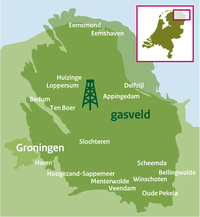
Photo from wikipedia
Relatively little research has been conducted to systematically quantify the nationwide earthquake risk of gas pipelines in the United States; simultaneously, national guidance is limited for operators across the country… Click to show full abstract
Relatively little research has been conducted to systematically quantify the nationwide earthquake risk of gas pipelines in the United States; simultaneously, national guidance is limited for operators across the country to consistently evaluate earthquake risk of their assets. Furthermore, many challenges and uncertainties exist in a comprehensive seismic risk assessment of gas pipelines. As a first stage in a systematic nationwide assessment, we quantify the earthquake risk of gas transmission pipelines in the conterminous United States due to strong ground shaking, including the associated uncertainties. Specifically, we integrate the U.S. Geological Survey 2018 National Seismic Hazard Model, a logic tree-based exposure model, three different vulnerability models, and a consequence model. The results enable comparison against other risk assessment efforts, encourage more transparent deliberation regarding alternative approaches, and facilitate decisions on potentially assessing localized risks due to ground failures that require site-specific data. Based on the uncertainties approximated herein, the resulting sensitivity analyses suggest that the vulnerability model is the most influential source of uncertainty. Finally, we highlight research needs such as (i) developing more vulnerability models for regional seismic risk assessment of gas pipelines, (ii) identifying, prioritizing, and measuring input pipeline attributes that are important for estimating seismic damage, and (iii) better quantifying seismic hazards with their uncertainties at the national scale, for both ground failures and ground shaking.
Journal Title: ASCE-ASME Journal of Risk and Uncertainty in Engineering Systems, Part A: Civil Engineering
Year Published: 2022
Link to full text (if available)
Share on Social Media: Sign Up to like & get
recommendations!